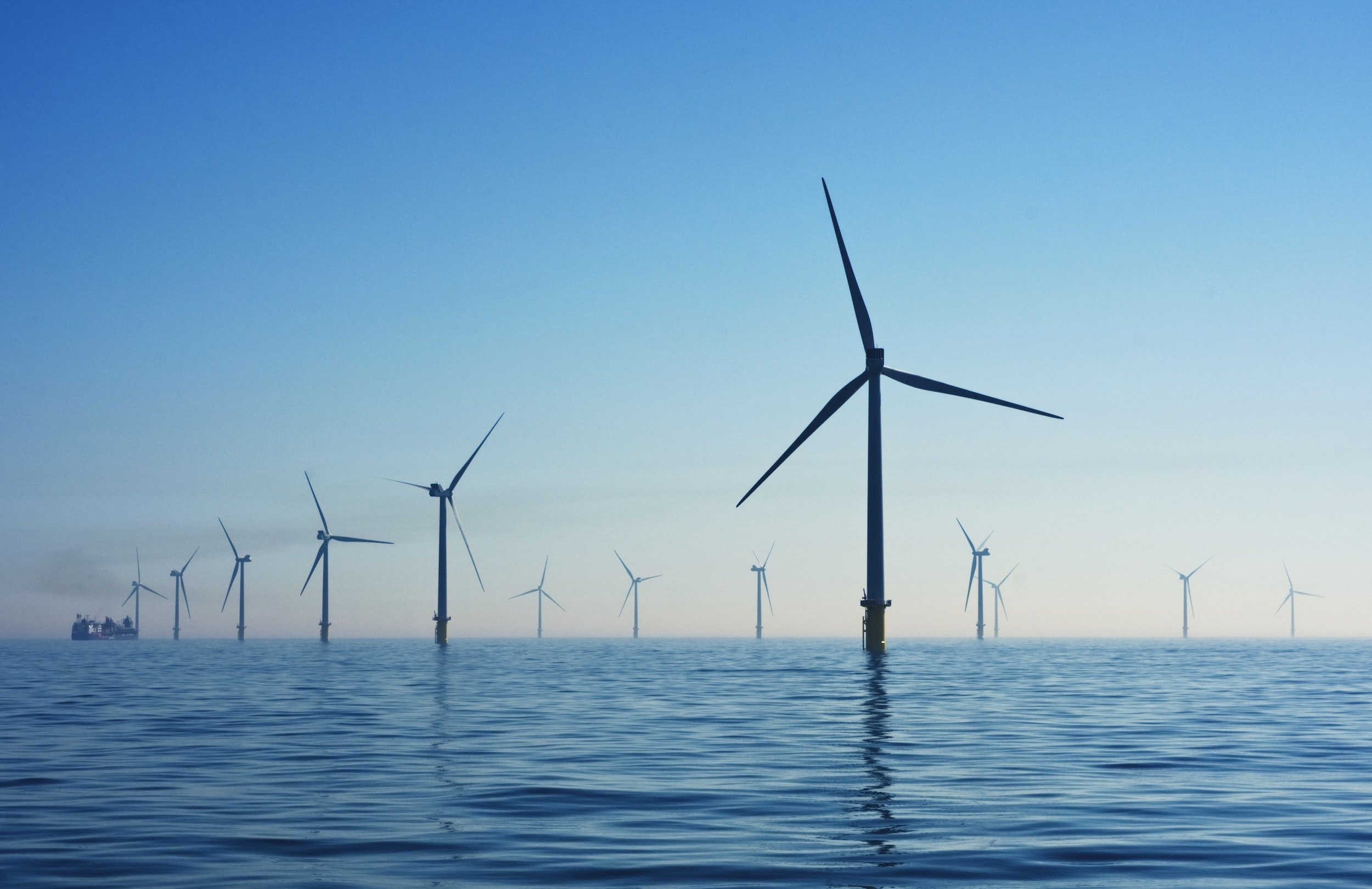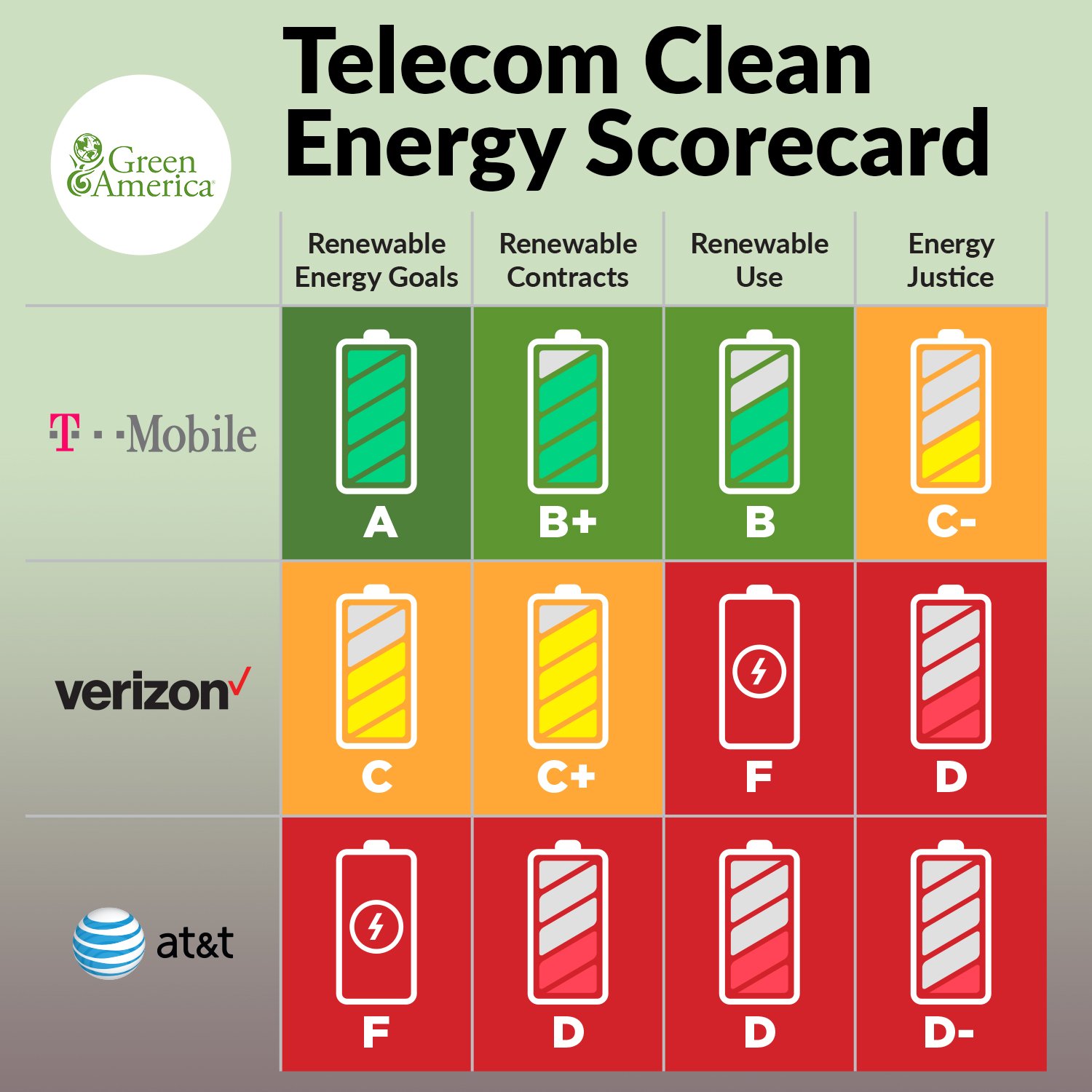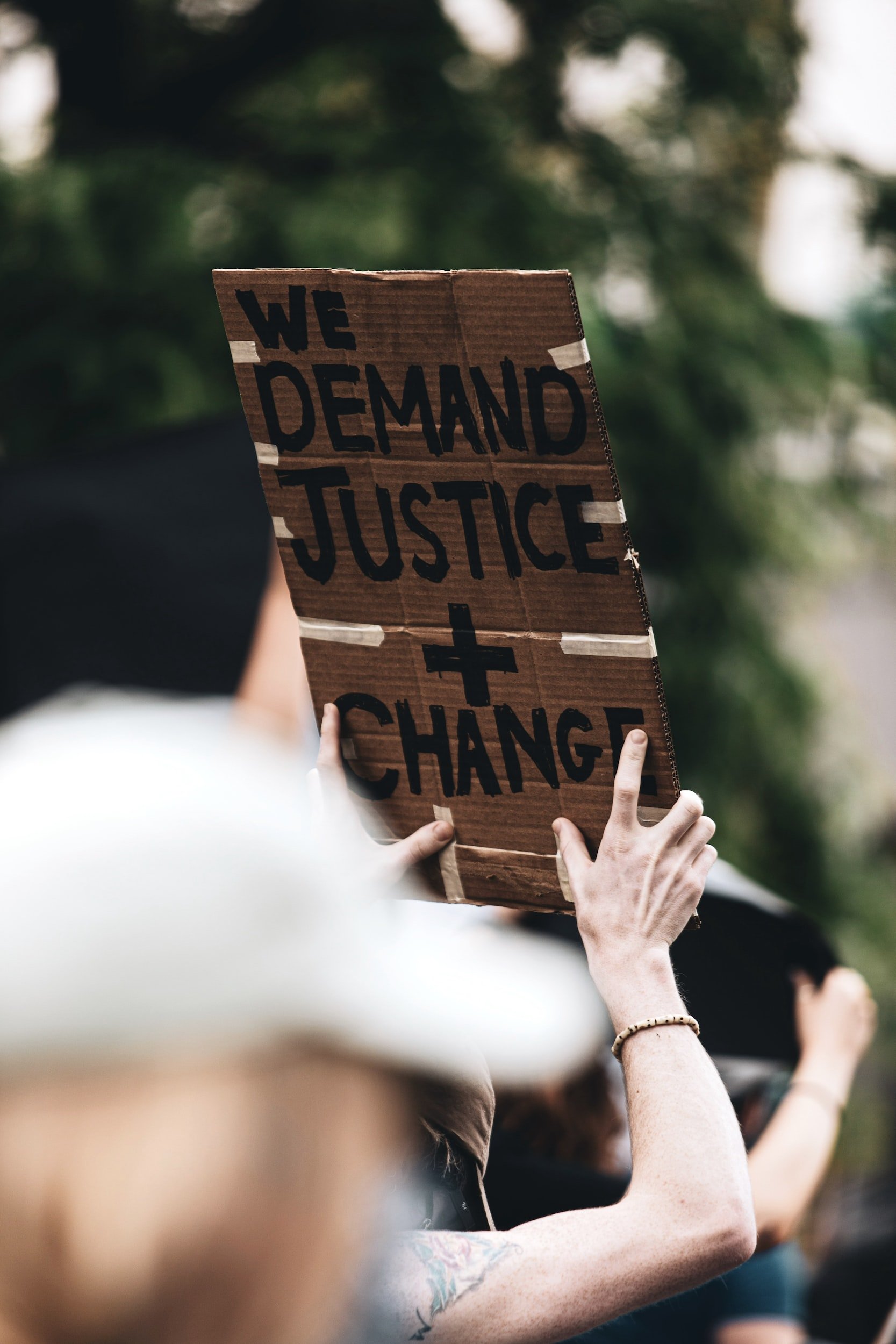Calling for a Just, Clean Transition
Green America investigated the clean energy use of major telecom companies and whether the energy they use advances energy justice.
This is a summary of findings. The complete report, including sourcing, is available here.
Use the buttons below to jump to a section.
Why Telecoms?
In 2021, AT&T had $168 billion in revenues, Verizon $133 billion, and T-Mobile $80 billion. With these revenues, paired with their massive energy use, the companies have a great deal of influence over how electricity is generated and used. They also have a great deal of responsibility to the communities they serve and those where energy impacts are highest. If this energy is produced from fossil fuels, it results in mining and drilling, polluting power plants, toxic wastes, and pipelines in vulnerable communities who therefore bear the brunt of the pollution created to power these companies.
AT&T, Verizon, and T-Mobile collectively use as much energy as all the households in NYC each year. Green America is calling on the three major US telecom companies to:
Commit to 100% renewable energy that puts new solar or wind on the grid by 2025
Ensure that their renewable energy purchases advance energy justice
The big telecom companies, AT&T, Verizon, and T-Mobile use massive amounts of electricity and bring in enormous revenues.
The Climate Crisis
& Renewable Energy As A Solution
The climate crisis is no longer looming—it is here. Severe storms, wildfires, biodiversity loss, disease, extreme heat, sea-level rise, and other catastrophic impacts of human-induced climate change have infiltrated our global experience of life on Earth.
The accelerating climate crisis calls for a dramatic reduction in the emission of greenhouse gases, with the UN calling for renewable energy to power 80 percent of electricity by 2030. Our goals for increasing the amount of renewable energy usage will be buoyed by major companies like the telecoms industry demanding their energy providers move to renewable sources. It’s an ambitious and necessary proposition. The US must install 85 GW of renewable energy (solar and wind) each year through 2035 to achieve emissions reductions targets of 80% reduction in carbon emissions in the energy sector by 2030 and 100% decarbonization by 2035.
12%
of US electric comes from renewables currently
80%
US renewable energy needed by 2030
-
The renewable energy industry is growing and the benefits go beyond just clean production that reduces pollution. The industry is also beneficial economically.
A recent report, Clean Jobs, Better Jobs, found that clean energy jobs on average pay an hourly wage that is roughly 25 percent higher than the median, and that clean energy jobs pay more than fossil fuel jobs.
Jobs in the clean energy sector are also more likely to be unionized than in the economy overall – although there is ample room for growth – which leads to better pay and benefits.
Clean energy jobs also employ more people; three times as many as fossil fuel extraction and generation.
The telecom sector, and other large-scale energy purchasers will also benefit economically from large-scale clean energy purchases as well. Consultant McKinsey & Company notes that energy makes up five percent of operating expenditures, and as energy usage increases with 5G, energy efficiency measures and renewable energy could lower costs by 15 to 20% per year. When T-Mobile announced its commitment to 100% renewable energy by 2021, the company noted that the move would save it nearly $100 million over 15 years.
-
There is much discussion among industry and policy professionals about the best ways to reduce a company’s emissions. Some companies are setting goals to reach 100% renewable energy purchases to power themselves. This could include solar, wind, geothermal, and energy storage. These commitments are verifiable based on the company’s energy contracts. Net zero pledges are admirable in theory, but the levers a company uses to meet the goals must be transparent and verifiable. For example, carbon offsets, including planting trees, is one lever often used to reach net zero targets. However, recent studies have found that while planting trees is a good thing to do, many of these ambitious projects fail to achieve meaningful carbon reduction for numerous reasons. Using offsets also enables companies to continue polluting already burdened communities by deriving electricity from fossil fuels, perpetuating environmental injustice and undermining greenhouse gas reduction goals.
Within the telecom sector, companies are claiming that the use of their technologies by customers, such as enabling increased teleworking or smart IoT and edge computing technologies, results in significant climate emission reductions. These claims are based on a number of assumptions and any gains are based on estimations. In order to effectively reduce climate emissions, corporate net zero goals need to be achievable, verifiable, and based on proven strategies.
One significant source of greenhouse gas emissions in the telecom sector is from electricity purchased from third parties to operate servers, cell phone towers, and other telecoms infrastructure. Therefore, an important pathway to lowering emissions is to switch energy usage from fossil fuels to renewable sources. In order to do their part in ensuring the world meets a target of 1.5 degrees Celsius of warming, telecoms need to ramp up their renewable energy purchases to 100% of energy used by 2025.
Shifting from fossil fuels to renewables is a key component to advancing environmental justice. Fossil fuel extraction, combustion, and waste disproportionately impact communities of color, leading to significant health impacts.
Social Justice in Clean Energy
In the transition to renewables, it is also essential to ensure that jobs in wind and solar benefit impacted and under-served communities. Currently, women of all races, and Black, Latino, and Indigenous peoples are underrepresented in the clean energy workforce. And when solar and wind facilities are built in or near vulnerable communities, those communities must have key roles in the process and obtain benefits from the installations.
The metrics used to assess the companies on energy justice are available in Part 1 of this report.

Company Rankings
GhG Emissions
9,179,567 tons
Renewables
14% (2021)
Clean Energy Goals
No Stated Goal
Renewables Use Grade
Energy Justice Grade
-
Green America has not found any publicly available criteria from AT&T regarding energy equity and community impact considerations in its renewable energy contractor selection process. When requested, the company has not provided such information. To determine commitment and progress toward energy justice for AT&T, we reviewed the energy justice markers of each of the companies AT&T uses to procure renewable energy.
Given its sourcing from Duke, Invenergy, Next Era and Vitol, and the issues described above, AT&T’s energy procurement choices carry mostly negative implications for energy justice. Both Duke and Invenergy are problematic in terms of what is arguably the most direct metric of energy justice - the extent to which fossil fuel-burning energy production sites harm environmental justice communities. Consultation with communities appears to be lacking in both instances, and information regarding amelioration of energy burdens is either missing, or suggestive of conflicts with low-to-moderate income (LMI) ratepayers. Though both companies may have fared better with regard to providing economic opportunities for women and people of color, information was too insufficient and/or contradictory to make a blanket statement to that effect. Invenergy did report strong progress with regard to internal hiring and diversity and inclusion initiatives, and Duke did report strong performance relative to diverse supplier procurement. Overall, Next Era rated relatively well on several energy justice markers.
GhG Emissions
7,334,090 tons
Renewables
97% (2021)
Clean Energy Goals
100 % by 2021
Renewables Use Grade*
Energy Justice Grade
*While T-Mobile reports reaching its 100% renewable energy goal, half of their renewable energy is from unbundled RECs which likely will not put new solar or wind on the grid.
-
Of the three Telecoms companies assessed, T-Mobile’s energy choices appear most progressive in terms of energy justice impacts but are still far from sufficient. The company responded to Green America’s survey and reported that its engagement with communities around renewable energy siting consisted of meeting with community leaders, ribbon cuttings, and engaging with local schools and colleges. None of these activities mean that T-Mobile is ensuring that local communities benefit from renewable energy. T-Mobile did report that one of its contracted clean energy projects is with Duke Energy, which is expected to spend 21% of development dollars with women and minority-owned businesses, but overall Duke Energy rated poorly on our energy justice markers.
In terms of workforce diversity, T-Mobile reports that it is engaged in a NextTech program to diversify the wireless workforce and is also leading a Diversity in Clean Energy (DICE) Roundtable to explore workforce diversity in the clean energy sector; the need for this highlights the fact that diversity is currently lacking in the sector . T-Mobile also notes in its 2021 CSR report that it has an External Diversity and Inclusion Council and that it conducts community engagement, but the company does not provide specifics regarding the scope or impact of this council .
T-Mobile also reports siting its largest wind projects in EPA subGrid regions with emissions factors 13-24% higher than the national average, and notes that its renewable energy projects are sited across the US; this could help to alleviate pollution burdens in communities with cumulative impacts.
T-Mobile's support for community solar is also a positive step by the company in advancing energy justice.
We evaluated the energy companies T-Mobile contracts with renewable energy based on our energy justice markers.
Given the commitments reported by some of the companies T-Mobile contracts with to consult with communities, take measures to ameliorate siting concerns, and where applicable, ease energy burdens, the telecom company is somewhat ahead of the curve. Although it should be noted that T-Mobile does contract with Duke Energy, Southern Energy (Southern Company), and Dominion (either directly or indirectly), three utilities with a long history of utilizing fossil-fuel power plants and infrastructure. In general, the energy companies chosen by T-Mobile demonstrated varying degrees of commitment to internal diversity and inclusion, and commitments to foster economic opportunity for diverse suppliers, but in aggregate indicated efforts to improve in these areas and the deployment of best practices.
GhG Emissions
19,605,256 tons
Renewables
3% (2021)
Clean Energy Goals
50% by 2025
Renewables Use Grade
Energy Justice Grade
-
Green America has not found any publicly available criteria from Verizon regarding energy equity and community impact considerations in its contractor selection process. When requested, the company has not provided such information. As a proxy for Verizon’s energy justice progress, we researched the energy justice records of the companies from which Verizon contracts renewable energy.
Verizon has renewable energy purchase agreements with Invenergy, Clearway, Brookfield, First Solar, Inc., Lightsource bp, EDF Renewables, NextEra, Leeward Renewables, and Duke. Overall, the companies Verizon sources from engage in a lack of transparency around important energy justice markers. For example, Verizon’s procurement of energy from Invenergy and Clearway, neither of which are particularly transparent around energy markers related to siting, stakeholder consultation or energy justice burdens, were found to be problematic. And even the companies that offer zero carbon emissions energy, including Brookfield and First Solar, experienced significant equity issues with siting. In general, the energy companies Verizon contracts with are ostensibly striving for progress around internal diversity, but reporting was somewhat vague and demographics tended to skew white and male. Overall, the companies Verizon sources from did not expressly iterate commitments to supporting entrepreneurship for XBE suppliers. While not as demonstrably egregious as Duke surrounding energy justice, these energy companies could not be considered leaders in a just energy transition.

The Need for Action on Renewable Energy and Energy Justice
As the impacts of climate change increase, and as disinvested communities continue to bear the burden of our reliance on fossil fuels, the telecom sector needs to do more to advance both renewable energy and energy justice. All three telecoms need to source 100% renewable energy that puts new wind and solar on the grid and need to ensure that these renewable energy purchases further energy justice.
Telecoms should adopt criteria to advance environmental justice into their RFPs for renewable energy. In consultation with energy justice advocates, Green America created a robust set of criteria for RFPs that incorporates communities and workers in the growing renewable energy economy. If telecoms used their significant market power and adopted these criteria into their RFPs, it would signal to energy companies that in order to remain competitive, they need to make progress on inequity and environmental impacts, and work to create a socially just, clean energy transition in energy procurement operations.
Customers of each of the telecoms can play a role in encouraging each company to contract for 100% of its energy from new solar and wind power sources, while also ensuring that communities and workers most harmed by fossil fuels are fully benefiting from the transition to renewables. Individual consumers can take action through Green America’s Hang Up on Fossil Fuels campaign.
The metrics used to assess the companies on energy justice are available in Part 1 of this report.
Thank you, Carla Itzkowich, for your generous support of this campaign.














